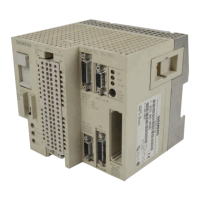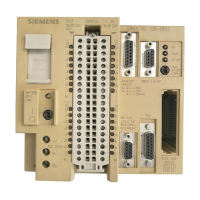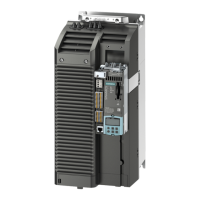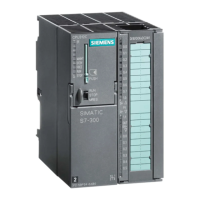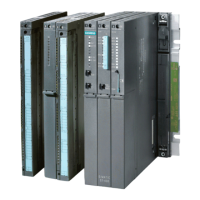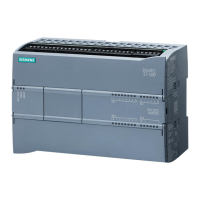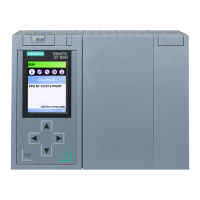Do you have a question about the Siemens S5-100U and is the answer not in the manual?
Describes the physical layout and modular design of the S5-100U, including its components.
Explains how the S5-100U processes programs using its functional units, RAM, and I/O bus.
Details the steps for mounting power supply, CPU, bus units, and I/O modules on mounting rails.
Covers connection methods, including SIGUT screw-type terminals and crimp snap-in terminals for modules.
Explains power supply circuits, control circuits, and load circuits for the S5-100U system.
Describes best practices for cable routing, shielding, and EMC measures to ensure reliable operation.
Provides basic operating instructions for the CPU operator panel, including ON/OFF switch and operating modes.
Offers suggestions for configuring and safely installing the programmable controller and its components.
Explains automatic and manual procedures for loading programs from memory submodules into the CPU.
Details how to back up the control program from the CPU's program memory to a memory submodule.
Explains how to interpret LED indications on the operator panel to identify error types and causes.
Covers CPU malfunctions, including the ISTACK analysis function for identifying error causes.
Guides users on locating error addresses within the program and tracing program execution using BSTACK.
Explains the consecutive numbering of slots for single-tier and multi-tier configurations.
Details the addressing format for digital modules, consisting of byte address and channel number.
Describes the addressing range and memory requirements for analog modules.
Explains the organization of PII and PIQ into address areas reserved for digital, analog modules, and intermediate results.
Introduces the STEP 5 programming language, its methods of representation, and operand areas.
Describes the two program types: linear and structured, and the advantages of structured programming.
Details the characteristics of different block types: OB, PB, SB, FB, and DB.
Covers fundamental operations like Boolean logic, Set/Reset, Load/Transfer, Timer, Counter, Comparison, and Arithmetic operations.
Explains advanced operations like Disable/Enable Interrupt, DO, Jump, and Substitution operations.
Details system operations that access system data directly, intended for experienced users.
Explains how condition codes are generated by comparison, arithmetic, shift, and conversion operations.
Explains how to configure parameters in DB1 for functions like real-time clock, SINEC L1, and system parameters.
Introduces standard function blocks like Code Converter, Multiplier, and Divider integrated into the CPU.
Details integrated OBs such as Scan Time Triggering OB31, Battery Failure OB34, and OB251 PID Algorithm.
Explains how OB2 is called by process interrupts to handle interrupt-driven program processing.
Provides a method to calculate the total interrupt reaction time by summing basic and additional reaction times.
Introduces analog input modules and their function in converting analog signals to digital values.
Covers rules for connecting sensors, including multi-channel operations, compensating boxes, and reference potentials.
Explains how analog output modules convert CPU bit patterns into analog output voltages or currents.
Details using function blocks FB250 for reading and scaling analog values, and FB251 for outputting analog values.
Outlines the capabilities of the integral real-time clock, including clock/calendar, prompt/alarm, and operating hours counter functions.
Provides procedures for setting clock parameters using DB1, including defaults and manual resets.
Offers examples for setting the clock, prompt time, and operating hours counter within DB1.
Details the physical connection of the S5-100U to the L1 bus cable using bus terminal BT 777.
Explains the parameters required for data exchange via the L1 bus, including send/receive mailboxes.
Guides on creating the control program for data exchange, relying on coordination information.
Provides general technical specifications covering environmental conditions, EMC, and safety information.
Lists technical specifications for PS 930 and PS 931 power supply modules.
Details technical specifications for CPU 100, CPU 115, CPU 102, and CPU 103.
Presents technical specifications for various digital input, output, and input/output modules.
Provides technical specifications for analog input and output modules, covering ranges and wiring.
Describes the comparator module, its function, installation, wiring, addressing, and typical applications.
Details the timer module, its function, installation, wiring, addressing, and typical applications.
Covers the diagnostic module's function for monitoring the S5-100U I/O bus and LEDs.
Explains the counter module's function, initial settings, setpoint loading, and enabling.
Details the high-speed counter module, its function, settings, pulse evaluation, and addressing.
Introduces the IP 262 module, its operation modes, and use in industrial processing technology.
Explains the IP 267 module, its principle of operation, and how it handles positioning operations.
Covers communications modules like CP 521 Printer and CP 521 BASIC, detailing their functions.
Provides a comprehensive list of STEP 5 operations, categorized by type with execution times.
A glossary of abbreviations used throughout the manual, aiding in understanding technical terms.
Provides detailed dimensions for the S5-100U CPU module, essential for panel layout and physical integration.
Describes the physical layout and modular design of the S5-100U, including its components.
Explains how the S5-100U processes programs using its functional units, RAM, and I/O bus.
Details the steps for mounting power supply, CPU, bus units, and I/O modules on mounting rails.
Covers connection methods, including SIGUT screw-type terminals and crimp snap-in terminals for modules.
Explains power supply circuits, control circuits, and load circuits for the S5-100U system.
Describes best practices for cable routing, shielding, and EMC measures to ensure reliable operation.
Provides basic operating instructions for the CPU operator panel, including ON/OFF switch and operating modes.
Offers suggestions for configuring and safely installing the programmable controller and its components.
Explains automatic and manual procedures for loading programs from memory submodules into the CPU.
Details how to back up the control program from the CPU's program memory to a memory submodule.
Explains how to interpret LED indications on the operator panel to identify error types and causes.
Covers CPU malfunctions, including the ISTACK analysis function for identifying error causes.
Guides users on locating error addresses within the program and tracing program execution using BSTACK.
Explains the consecutive numbering of slots for single-tier and multi-tier configurations.
Details the addressing format for digital modules, consisting of byte address and channel number.
Describes the addressing range and memory requirements for analog modules.
Explains the organization of PII and PIQ into address areas reserved for digital, analog modules, and intermediate results.
Introduces the STEP 5 programming language, its methods of representation, and operand areas.
Describes the two program types: linear and structured, and the advantages of structured programming.
Details the characteristics of different block types: OB, PB, SB, FB, and DB.
Covers fundamental operations like Boolean logic, Set/Reset, Load/Transfer, Timer, Counter, Comparison, and Arithmetic operations.
Explains advanced operations like Disable/Enable Interrupt, DO, Jump, and Substitution operations.
Details system operations that access system data directly, intended for experienced users.
Explains how condition codes are generated by comparison, arithmetic, shift, and conversion operations.
Explains how to configure parameters in DB1 for functions like real-time clock, SINEC L1, and system parameters.
Introduces standard function blocks like Code Converter, Multiplier, and Divider integrated into the CPU.
Details integrated OBs such as Scan Time Triggering OB31, Battery Failure OB34, and OB251 PID Algorithm.
Explains how OB2 is called by process interrupts to handle interrupt-driven program processing.
Provides a method to calculate the total interrupt reaction time by summing basic and additional reaction times.
Introduces analog input modules and their function in converting analog signals to digital values.
Covers rules for connecting sensors, including multi-channel operations, compensating boxes, and reference potentials.
Explains how analog output modules convert CPU bit patterns into analog output voltages or currents.
Details using function blocks FB250 for reading and scaling analog values, and FB251 for outputting analog values.
Outlines the capabilities of the integral real-time clock, including clock/calendar, prompt/alarm, and operating hours counter functions.
Provides procedures for setting clock parameters using DB1, including defaults and manual resets.
Offers examples for setting the clock, prompt time, and operating hours counter within DB1.
Details the physical connection of the S5-100U to the L1 bus cable using bus terminal BT 777.
Explains the parameters required for data exchange via the L1 bus, including send/receive mailboxes.
Guides on creating the control program for data exchange, relying on coordination information.
Provides general technical specifications covering environmental conditions, EMC, and safety information.
Lists technical specifications for PS 930 and PS 931 power supply modules.
Details technical specifications for CPU 100, CPU 115, CPU 102, and CPU 103.
Presents technical specifications for various digital input, output, and input/output modules.
Provides technical specifications for analog input and output modules, covering ranges and wiring.
Describes the comparator module, its function, installation, wiring, addressing, and typical applications.
Details the timer module, its function, installation, wiring, addressing, and typical applications.
Covers the diagnostic module's function for monitoring the S5-100U I/O bus and LEDs.
Explains the counter module's function, initial settings, setpoint loading, and enabling.
Details the high-speed counter module, its function, settings, pulse evaluation, and addressing.
Introduces the IP 262 module, its operation modes, and use in industrial processing technology.
Explains the IP 267 module, its principle of operation, and how it handles positioning operations.
Covers communications modules like CP 521 Printer and CP 521 BASIC, detailing their functions.
Provides a comprehensive list of STEP 5 operations, categorized by type with execution times.
A glossary of abbreviations used throughout the manual, aiding in understanding technical terms.
Provides detailed dimensions for the S5-100U CPU module, essential for panel layout and physical integration.
| Programming Language | STEP 5 |
|---|---|
| Type | PLC |
| Power Supply | 24V DC |
| I/O Modules | Digital and Analog I/O modules available |
| Analog Inputs | Up to 32 |
| Communication | RS-232 |
| Memory | RAM |
| Operating Temperature | 0°C to 60°C |

